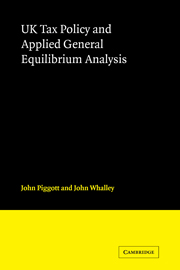Book contents
- Frontmatter
- Contents
- PREFACE
- ACKNOWLEDGEMENTS
- INTRODUCTION AND SUMMARY OF STUDY
- PART I The General Equilibrium Model of the UK – Structure, Data and Model Solution.
- PART II Empirical Analysis of the UK Tax/Subsidy System Using the General Equilibrium Model
- SUMMARY AND CONCLUSIONS
- APPENDIX A Structure of the Basic Variant Model
- APPENDIX B Notes to Tables Appearing in Chapter 5
- APPENDIX C Notes on Programming and Computation
- BIBLIOGRAPHY
PART I - The General Equilibrium Model of the UK – Structure, Data and Model Solution.
Published online by Cambridge University Press: 04 August 2010
- Frontmatter
- Contents
- PREFACE
- ACKNOWLEDGEMENTS
- INTRODUCTION AND SUMMARY OF STUDY
- PART I The General Equilibrium Model of the UK – Structure, Data and Model Solution.
- PART II Empirical Analysis of the UK Tax/Subsidy System Using the General Equilibrium Model
- SUMMARY AND CONCLUSIONS
- APPENDIX A Structure of the Basic Variant Model
- APPENDIX B Notes to Tables Appearing in Chapter 5
- APPENDIX C Notes on Programming and Computation
- BIBLIOGRAPHY
Summary
In Part I of our study we set out the structure of the general equilibrium model of the UK economy and tax/subsidy system that we have constructed. We also present the data used to calibrate the model and generate parameter values, along with a description of the methods used to obtain parameter values and solve the model for counter-factual equilibria.
In Chapter 1 we outline our approach to general equilibrium tax analysis stressing the basic analytical structure within which we work. In Chapter 2 we make this structure more concrete by specifying our model of the UK economy. We list the industry, commodity, and consumer groups we consider; and describe our functional forms, our treatment of government, external trade, savings and investment, and other features of the model. In Chapter 3 we discuss the UK tax/subsidy system, detailing its major distorting impacts and outlining our model treatment of each component of this system.
Chapter 4 describes the approach we have taken to calibration of the model in the generation of parameter values, and in Chapter 5 we give a complete description of the benchmark equilibrium data set which we have constructed for 1973 for use in calibration. Chapter 6 discusses the elasticity values which we have chosen in our functions. The appendices present an algebraic representation of the model, provide notes on data set construction, and report on our programming and computational experience.
- Type
- Chapter
- Information
- Publisher: Cambridge University PressPrint publication year: 1985



